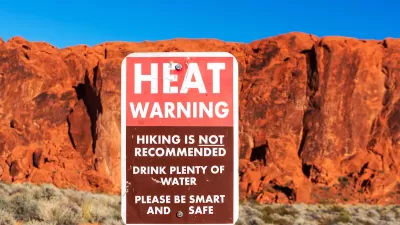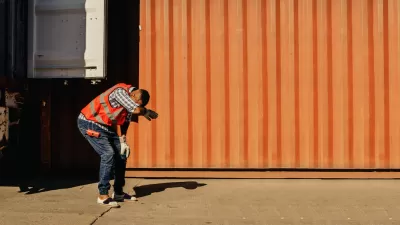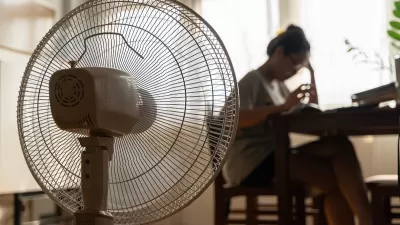This summer is predicted to be one of the hottest on record, and heat waves will likely put physical and social infrastructure to the test.

Extreme heat is threatening more communities with intense heat waves that take a sometimes deadly toll on public health, resources, and energy infrastructure. In 2021, an unprecedented heat wave struck the Pacific Northwest, shattering temperature records and killing more than 1,000 people in Canada and hundreds in Washington and Oregon. In 2022, roughly 1,670 people died of heat-related causes, the highest such number in at least two decades. And after the summer of 2023 broke temperature records around the world, 2024 is shaping up to be another scorcher.
In addition to the expected impacts — dangerous conditions for unhoused people living outdoors and those without air conditioning or other cooling options, increased wildfire risk, and outsized energy use — extreme heat has been shown to negatively impact heart health, student test scores, damage transit equipment and infrastructure, and exacerbate drought conditions. In dense cities with large amounts of pavement, the urban heat island effect raises temperatures, disproportionately impacting low-income communities with low access to parks and green spaces. Heat waves force people to use more air conditioning, straining power grids. Heat causes damage to roads, rails, and other transportation infrastructure, forcing closures and delays of key transportation systems.
Government response
Today, extreme heat has become elevated from an occasional weather quirk to a serious and ongoing public health crisis. Around the country and the world, governments are mobilizing to address rising temperatures, build more resilient cities, and offer relief to residents. From establishing heat mitigation departments to expanding access to public swimming pools and cooling centers, cities are increasingly looking at extreme heat as a major public health and policy issue.
Cities and counties including Phoenix, Los Angeles, and Miami-Dade have all created ‘Chief Heat Officer’ positions that are tasked with coordinating heat mitigation efforts across city agencies. Cities must deal with growing energy demand and aging grid infrastructure and balance the need for life-saving energy with emissions reduction goals.
Regulations like the state of Oregon’s rules around air conditioning can help protect renters and other vulnerable residents, though critics of that law say it offers too many exemptions that could leave tenants without access to air conditioning. And while air conditioning can be a lifesaving essential for residents, it also raises energy costs and emissions.
To combat the urban heat island effect and reduce temperatures in densely populated neighborhoods, some cities are experimenting with large-scale cool pavement and cool roof treatments, specialized coatings that can be applied to surfaces to reduce heat absorption and decrease ambient temperature. While these treatments have been used on individual roofs and properties, new initiatives are looking to scale up these efforts to compound their impacts on entire neighborhoods. Increasing the urban tree canopy and adding green spaces can also help lower temperatures and offer healthy spaces for residents to avoid the heat.
Extreme heat impacts planning in a variety of ways. From protecting the energy supply to safeguarding transportation infrastructure and improving public health, urban planners and city officials can take actions that mitigate the impacts of extreme heat and protect residents from negative health effects. As average temperatures rise, heat mitigation is moving to the forefront as an urgent and far-reaching issue.

Planetizen Federal Action Tracker
A weekly monitor of how Trump’s orders and actions are impacting planners and planning in America.

San Francisco's School District Spent $105M To Build Affordable Housing for Teachers — And That's Just the Beginning
SFUSD joins a growing list of school districts using their land holdings to address housing affordability challenges faced by their own employees.

The Tiny, Adorable $7,000 Car Turning Japan Onto EVs
The single seat Mibot charges from a regular plug as quickly as an iPad, and is about half the price of an average EV.

With Protected Lanes, 460% More People Commute by Bike
For those needing more ammo, more data proving what we already knew is here.

In More Metros Than You’d Think, Suburbs are Now More Expensive Than the City
If you're moving to the burbs to save on square footage, data shows you should think again.

The States Losing Rural Delivery Rooms at an Alarming Pace
In some states, as few as 9% of rural hospitals still deliver babies. As a result, rising pre-term births, no adequate pre-term care and "harrowing" close calls are a growing reality.
Urban Design for Planners 1: Software Tools
This six-course series explores essential urban design concepts using open source software and equips planners with the tools they need to participate fully in the urban design process.
Planning for Universal Design
Learn the tools for implementing Universal Design in planning regulations.
Smith Gee Studio
City of Charlotte
City of Camden Redevelopment Agency
City of Astoria
Transportation Research & Education Center (TREC) at Portland State University
US High Speed Rail Association
City of Camden Redevelopment Agency
Municipality of Princeton (NJ)






























